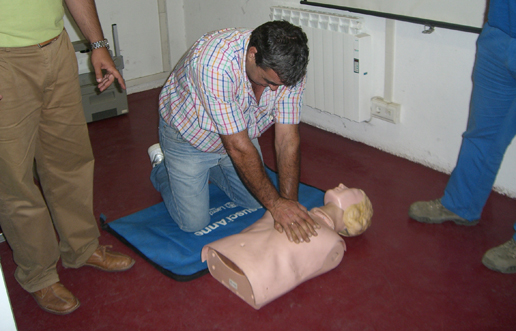First Aid
6. What to do in Case of Electrocution?
Electrocution is when a person suffers cardiorespiratory arrest or loses consciousness as a consequence of an electrical discharge.
The conduct to follow when faced with a casualty who has been electrocuted may be summarised in three simple though precise phrases:
- 1. Request help.
- 2. Rescue or “disengage” the injured person.
- 3. Apply first aid to keep the injured person alive until medical aid arrives .
1. Request help
The first measure to be taken is to raise the alarm so that someone assumes responsibility for calling the emergency medical service while you try to give aid to the injured person.
2. Rescue or disengage the injured person
If the injured person is still in Contact with a low voltage conductor or part, the first measure to take is to separate him from such Contact before trying to apply first aid. To do so:
- a) Disconnect the current by means of the switch, cut-out mechanism or circuit-breaker, etc. Do not forget that an electrocuted person located at a height runs the risk of falling to the ground in the moment the current is cut-off. In such cases, attempts must be made to allay the fall by means of mattresses, clothes, rubber or holding a taut canvas or blanket between a number of people.
- b) If the current cannot be cut-off or it takes too long due to the switch being far away, try to disengage the electrocuted person using any non-conducting element (board, strip of wood, rope, wooden chair, leather belt, stick or dry branch, etc.) to grab hold of the wire or the injured person from a distance, or grab his clothes, provided the first-aider is well insulated.
3. First Aid
After an electric discharge, a state of apparent death often presents itself, possibly due to a loss of consciousness, respiratory arrest or circulatory arrest.
Each of these cases requires different conduct:
a) Loss of consciousness
There may be temporary loss of consciousness, but no respiratory arrest. The heart beat and pulse are perceptible.
In this case, it is sufficient to lie the injured person on his side in the safety position.
The lateral safety position consists in lying the injured person on his side so that, should he vomit, expel blood or secretions through his mouth, he does not choke.
The steps to follow are:
- 1). Bend the leg of the injured person nearest to the first-aider.
- 2). Place the hand of the injured person nearest to the first-aider under his buttock.

- 3). Pull the arm of the injured person furthest away from the first-aider and place it around his side.
- 4). Place the hand of the injured person under his cheek, leaving his head in the “neutral position” (neither bent nor extended).
It is also important to check his breathing and the state of blood circulation while medical assistance arrives.
b) Respiratory arrest
In this case, clear symptoms of respiratory arrest appear in addition to the loss of consciousness. However, the injured person’s pulse is perceptible. Respiratory assistance is to be commenced immediately, preferably using the mouth-to-mouth method.
c) Circulatory arrest
In this case, the absence of a heart beat is added to the state of unconsciousness and the absence of breathing. It is very important in this case to begin CPR (cardiopulmonary resuscitation) manoeuvres, i.e. combining mouth-to-mouth respiration with external cardiac massage.





